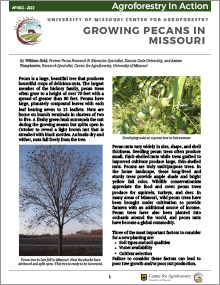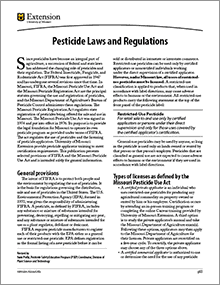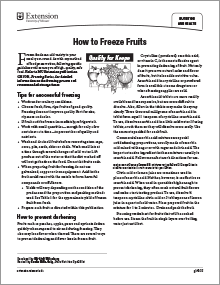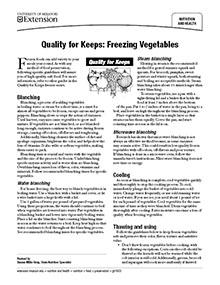The following publications cover topics related to Commercial Horticulture. For a complete list of MU Extension publications, visit the main Publications page.
Drying Flowers and Foliage for Arrangements
Reviewed
Create distinctive indoor decorations by drying flowers and foliage. Air-drying, pressing, using dessicants, microwave oven-drying and freeze-drying methods plus preserving foliage with glycerin are covered in this illustrated MU Extension guide.
Soil Testing in Missouri
Reviewed
Find out how fertile your garden or lawn soil is with a soil test. Results estimate the ability of soil to supply plant nutrients or support plant growth. Learn the process of taking a soil sample and the tools necessary to do so in this guide.
Lawn and Garden Soil Test Interpretations and Fertilizer Recommendation Guide
Reviewed
Eliminate the guesswork of providing nutrients for plant growth and avoid potentially environmentally harmful fertilizer applications by having your home lawn and garden soil tested. Learn the methods used by the MU Soil and Plant Testing in this guide.
Least-Toxic Control Methods to Manage Indoor Plant Pests
Reviewed
Learn safe and effective ways to manage indoor plant pests using natural, mechanical, and low-toxicity treatments that protect both plants and the environment
Twig Girdler and Twig Pruner
Reviewed
Twig Girdler and Twig Pruner are long-horned beetle species that attack numerous types of valuable trees. Visit our website to learn more.
Home Fruit Production: Peach and Nectarine Culture
Revised
This guide offers practical advice on selecting, planting, and maintaining peach and nectarine trees for optimal fruit production.
Caterpillars in Your Yard and Garden
Reviewed
Caterpillars are some of the most easily observed insects in backyards and gardens. Learn to identify them so you will know what type of butterflies or moths they will turn into.
Boxelder Bug
Reviewed
Boxelder bugs are black and red insects that may enter homes in fall. They don't cause damage but can be a nuisance. Control includes sealing entry points and removing host trees.
Controlling Voles in Horticulture Plantings and Orchards in Missouri
Reviewed
Learn to manage vole damage in Missouri's horticultural plantings and orchards with effective control strategies for these small mammals.
Using NRCS Technical and Financial Assistance for Agroforestry and Woody Crop Establishment Through the Environmental Quality Incentives Program (EQIP)
Revised
Learn how to access EQIP technical and financial assistance for alley cropping, multistory cropping, riparian buffer, silvopasture and windbreak practices.
Calibrating Sprayers and Spreaders for Athletic Fields and Golf Courses
Reviewed
Guidance on accurately calibrating sprayers and spreaders for effective turf pest control on athletic fields and golf courses.
Grass Clippings, Compost and Mulch: Questions and Answers
Reviewed
Yard waste is valuable landscape resource. Visit our site for our Grass Clippings, Compost and Mulch: Questions and Answers resource.
Caring for Flooded Lawns
Reviewed
Managing Nematodes in Gardens
Reviewed
Learn how to identify and manage nematodes in your garden with effective strategies to protect plants and improve garden health.
Pollinating Fruit Crops
Reviewed
Home Fruit Production: Grape Culture
Reviewed
This publication provides comprehensive guidance on grape cultivation, including cultivar selection, planting, and care practices.
Growing Pecans in Missouri
Revised
Pecan is a large, beautiful tree that produces bountiful crops of delicious nuts. Visit our site to learn about Growing Pecans in Missouri.
Pesticide Laws and Regulations
Revised
Learn about federal and Missouri pesticide rules, and see the steps to take to become a pesticide applicator and keep good records of when you use pesticides.
Taking Plant Cuttings
New
Grow new plants with cuttings from existing ones. Learn how to take a cutting and create an environment in which it can develop roots in this 2-page guide.
Agricultural Owners, Family Labor and the Worker Protection Standard
Revised
Find out what the EPA’s Worker Protection Standard requires of family-owned agricultural establishments to keep your family safe from pesticide exposure.
Sampling Safely at Farmers Markets — Fact Sheet
Reviewed
Read this to understand sampling regulations at farmers markets. Learn how to establish and estimate costs for handwash stations and washing and sanitizing stations.
How to Freeze Fruits
Reviewed
Learn how to freeze fruits effectively, including tips on preparation, preventing darkening, and approximate yields for various fruits.
How to Can Fresh Vegetables
Revised
Learn to safely can fresh vegetables in this research-based guide. Recommended pressure canner process times are provided.
How to Freeze Vegetables
Reviewed
From blanching, cooling and freezing to thawing and using, learn how to safely freeze vegetables — asparagus, beans, broccoli, cabbage, cauliflower, celery, corn, herbs, onions, peas, peppers, potatoes, tomatoes and more — in this MU Extension guide.
























